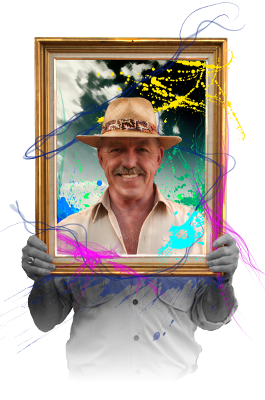I'm going to start with what is a painting?
SECTION 1.
'a radar on the landscape ahead'
Making a Mark and Making a Painting.
Where do I bloody start?
Let’s start by defining the subject of this book-painting.
What is the broadest definition of a painting we can give?
Answer: A painting is an assembly or combination of marks on a surface. The person who does this, with some apparent result is generally referred to as an artist/painter.
Does that mean that anyone who marks a surface is an artist?
Answer: In the very broadest sense the answer is, yes.
So the elephant who put paint on a sheet of paper at Nong Nooch village in eastern Thailand is an artist? According to this definition, the answer is again, yes. And that is exactly how Jumbo was described as I watched him slap paint around the other day during a very popular elephant show. After his painting was completed and sold to a fascinated Japanese tourist for 250 baht ($6.24) the elephant then went on to kick a soccer ball into a soccer net. Technically, I suppose, he then became a soccer player- otherwise known as a footballer- when that happened. People gave him bananas in appreciation for both endeavors- or was it consideration! And technically, I suppose, also the $6.24 consideration made Jumbo a professional artist as well, since it was money in exchange for a work of art.
Jumbo painting up a storm….
We will return to Jumbo later. Technically though, Jumbo doesn’t give a crap about the words-‘artist’ or ‘footballer’ or ‘professional’-all he wants is bananas! And the $6.24 cash payment converts to quite a big handful of bananas-technically speaking!
These definitions are too broad for me. I want to tighten them to make them more as I really view them. Anyone or thing that kicks a football into a net and receives consideration is not by my standards a professional footballer; nor is anyone, or thing, that can put a mark on a surface an artist-even though they get money!
But one thing so far is 70% right-any mark or marks on a surface is a painting, I suppose, if it conveys meaning and generates a response from an on-looker.
Now, I’ve got a zillion response buttons. Responses to do with shape, color, direction, size, position, tone and so on. Responses that spring from a stirred emotion.
If I was stirred by a mark made by a human then it has a connect value in as much as it was generated by a fellow human with a zillion response buttons like mine tied to an equally broad range emotions as mine. The mark, in other words, has an emotional quality.
Whoever put the marks together on the surface is connecting to my emotions through the ‘mark’.
If the mark, that I am responding to, was done by an elephant or a monkey though I would not take serious the connect value of the mark because it originated from something that does not have a human or sufficiently human-like emotional grid. I may see it as a humorous though!
Some people believe that because they see behavior that imitates our own in monkeys or elephants then such animal doodlings are therefore genuine art. My question to this is: Does that art reflect the history of mankind, or the history of monkey and elephant time? Does it spring from an emotion?
So a monkey combs the hair of its offspring; a female elephant about to give birth seeks out an ally to help her-actions which we relate to since we engage in similar behavior. We interpret the monkey to be maternal and the elephant chosen to assist to be a friend. Both emotionally based behaviors.
The question now is does the monkey or the elephant have the mental facility and manual dexterity to represent that emotion, or any other emotion, as group of marks on paper(=a painting), that we can understand and then relate to? The elephant in the show went through a series of movements with 2 brushes that were loaded with a selection of paint and given by his human assistant. The end result was some green trees with brown trunks. The elephant was rewarded with another handful of bananas. To jump from the picture of trees to saying that the elephant sought to connect to us an image of trees that was in its head, at that moment, is a major stretch. He was taught to do something that WE recognized. He didn’t have a clue what he was doing other than doing something to get a bunch of bananas!
I would call the art work that the elephant did just that-an art type of work, rather than a work of art. It should be seen in the context of the nature of the creative intelligence which delivered it. Until we can, like Dr Dolittle, actually talk to the animals the message is really only an ‘interesting or funny’ mark.
An event by way of a mark but without a message as we know it is simply a response to a physical requirement-just like the elephant taking a dump before it kicked the football was a response to his feelings of an imminent crap attack. For the Jumbo there was less emotion behind the painting then behind the dump. Both are nevertheless marks of interest! For jumbos fellow elephants the dump had more communication value than his ‘painting’.








0 comments:
Post a Comment